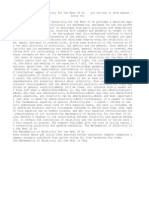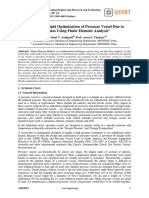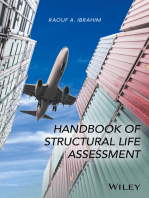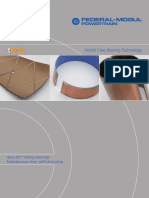Urn NBN Si Doc 0e2ilttz
Urn NBN Si Doc 0e2ilttz
Uploaded by
Oscar CruzCopyright:
Available Formats
Urn NBN Si Doc 0e2ilttz
Urn NBN Si Doc 0e2ilttz
Uploaded by
Oscar CruzOriginal Title
Copyright
Available Formats
Share this document
Did you find this document useful?
Is this content inappropriate?
Copyright:
Available Formats
Urn NBN Si Doc 0e2ilttz
Urn NBN Si Doc 0e2ilttz
Uploaded by
Oscar CruzCopyright:
Available Formats
Strojniki vestnik - Journal of Mechanical Engineering 54(2008)10, 685-692 Paper received: 02.01.
2008
UDC 621.772.4 Paper accepted: 07.07.2008
*
Corr. Author's Address: University of Osijek, Faculty of Agriculture, Trg Svetog Trojstva 3,
HR-31000 Osijek, Croatia, pavo.balicevic@pfos.hr
685
Strength of Pressure Vessels with Ellipsoidal Heads
Pavo Balievi
1,*
- Draan Kozak
2
- Tomislav Mrela
3
1
Josip Juraj Strossmayer University of Osijek, Faculty of Agriculture, Croatia
2
Josip Juraj Strossmayer University of Osijek, Mechanical Engineering Faculty in Slavonski Brod, Croatia
3
Josip Juraj Strossmayer University of Osijek, Faculty of Electrical Engineering, Croatia
A method for stress analysis in cylindrical pressure vessels with ellipsoidal heads, based on the
axisymmetric shell theory, was proposed. The starting point were the approximate solutions of the
differential equation system that were used to get mathematical expressions for determining internal
forces, moments and displacements in the vessel walls.
Final expressions that can be applied were acquired by joining the membrane and moment theory
and by setting and solving equations of boundary conditions. Diagrams that show distribution of internal
forces and moments are in dimensionless form which enables their use regardless of dimensions and
load. These expressions were used to develop a method for testing strength of pressure vessels with
ellipsoidal heads in the design phase. Application of the method was shown on a selected numerical
example, while a special computer programme was created for calculation purposes.
2008 Journal of Mechanical Engineering. All rights reserved.
Keywords: pressure vessels, ellipsoidal heads, internal forces, analytical solutions
0 INTRODUCTION
Because of the increasing use of pressure
vessels in all types of industry (e.g. oil-refining
industry, gas-processing industry, power plant
industry, etc.), in transportation, and other
processing facilities, and because of their many
side effects on the environment, there is a need
for accurate analysis of the shells in the design
phase. The designer must know the real
distribution of stresses, i.e. he must make
calculations and analysis of stress in all critical
parts of the vessel in order to make an adequate
pressure vessel design. Stress is highest at the
points of geometry parameter change, e.g. the
transition from the shell of the vessel to the head,
where higher wall bending usually occurs.
Simple empirical forms determined by
norms are used for making calculations of stress
in the walls of pressure vessels. This type of
calculation does not give the real distribution of
stress, the highest values or places where stress
occurs. More accurate stress analysis can be done
by using finite element method (FEM) or
analytical method.
Analytical method for calculating strength
of the thin-walled pressure vessels is based on the
theory of axisymmetric shells. This theory has a
system of the fourth order differential equation
with internal forces, moments and displacements
as unknown functions. The shell theory was
established by famous researchers (Lourye 1947,
Goldenveiser 1953, Novozhilov 1962 and others)
who developed analytical methods for
determining general solutions of the system.
Accurate solutions of the system can be acquired
in general form only for pressure vessels of
simple geometry (e.g. cylindrical, conical and
spherical). In order to apply those solutions in the
process of designing, we must calculate numerous
complex functions and infinite orders with
complex variables, and we must also set and
solve an equation of boundary conditions. These
solutions can be used to make calculations on a
computer, but the calculation procedure and the
algorithm structure are very complex.
Far simpler analytical procedure for
calculating pressure vessel strength can be
developed on the basis of approximate solutions
of axisymmetric shell theory equation system [1].
It is of vital importance because the approximate
solutions contain an error of the same order of
magnitude as do the correct solutions. Relative
error of those solutions is of the order h/R (ratio
of the wall thickness and the curvature radius),
which is less than 1/20 at thin-walled pressure
vessels, i.e. 5%, which can be neglected in
engineering calculations.
Approximate solutions of the shell theory
can be applied to pressure vessels with more
complex shells.
This paper presents solutions for a
cylindrical vessel with ellipsoidal heads. Final
mathematical expressions for calculating internal
Strojniki vestnik - Journal of Mechanical Engineering 54(2008)10, 685-692
Balievi P. - Kozak D. - Mrela T. 686
forces, moments and displacements in the walls
of head and cylindrical part were derived from
approximate solutions. By using those
expressions, and by connecting membrane and
moment theory, a method for determining
strength of pressure vessels with ellipsoidal
heads, which is suitable for designing, was
developed. A special computer programme was
created for the application of this method.
Computer calculation was done on a selected
numerical example, and the analysis results were
shown in a diagram.
1 MEMBRANE FORCES IN ELLIPSOIDAL
HEAD
Stresses in the walls of pressure vessels
occur due to different types of loads, depending
on the purpose of the vessel and on different
influences that a vessel is subjected to during
exploitation. Internal pressure has the biggest
influence on the amount of stress, so all other
types of loads are considered to be less important.
Solutions of the shell theory equation
show that internal forces which occur in the walls
of the vessel can be, under certain conditions,
determined by superimposing of two kinds of
loads, membrane and moment. These conditions
given in[2] are true for curvature radius
derivations of vessel meridian R
1
and surface load q
n
.
At membrane stress state, it is assumed
that only normal forces occur in the wall, while
shear forces and bending moments are not
considered. In the design phase, pressure vessels
should be formed so that the real stress is
approximately the same as the membrane state in
order to avoid bending of the walls and high
stresses due to bending.
Cylindrical pressure vessels usually have
semi-spherical, toroidal-spherical or ellipsoidal
heads. Stress is best distributed in ellipsoidal
heads. The middle plane of ellipsoidal head is
shaped like a half of the ellipsoid of revolution
which is the result of ellipse arc rotation around
its minor axis. A major ellipsoid semi-axis is
equal to cylindrical part radius (a = R), and a
minor semi-axis is equal to the head height (b =
H). A parameter determining ellipse form is
1 /
2 2
= b a , and + = 1
0
a R is curvature
radius of head vertex. Figure 1 shows the basic
measures of cylindrical pressure vessels, closed
by heads shaped like revolution ellipsoid half.
Fig.1. Pressure vessel with ellipsoidal heads
Internal forces in the head walls are
determined according to the membrane theory [2]
by using the following expressions:
( )
2 1
2
0
sin 1
1
2
'
+
+
=
R p
N
s
,
(1)
( )
( )
( )
' sin 1 '
0 2 0
s t
N N =
.
(2)
Membrane component of circular force
has (in places of shell connection) tensile
character on the cylinder, and compressive
character on the head, which leads to difference
in radial displacements according to [3]:
( ) ( )
( ) '' ' ,
2
0 0
r r
p R
u u 1
2 E h
= +
(3)
where:
( )
'
0
s
N - meridian normal force in the head wall,
( )
'
0
t
N - circular normal force in the head wall,
( )
'
0
r
u - radial displacement of the wall (at the
head),
( )
' '
0
r
u - radial displacement of the wall (at the
cylindrical part),
E - modulus of elasticity of the pressure vessel
wall,
h - thickness of the wall,
p - pressure in the vessel,
- meridian angle,
R - radius of cylindrical part of the vessel.
Strojniki vestnik - Journal of Mechanical Engineering 54(2008)10, 685-692
Strength of Pressure Vessels with Ellipsoidal Heads 687
Superscript
( ) 0
denotes values pertaining to
a membrane stress condition. Corresponding
boundary condition values will be denoted by the
superscript
( ) 1
, and those without the superscript
refer to total solutions.
As can be seen from the expression (1),
meridian normal force of ellipsoidal head changes
without interruption in the points of transition
from the ellipsoid to the cylinder, which is very
important for achieving the membrane state of
stress. Both normal forces (meridian and circular)
reach their maximum value in the head vertex.
Value = 3 should be chosen for ellipse
parameter, because maximum values of internal
forces in the head are the same as values of
circular force in the cylindrical part of the vessel.
There is a discontinuity of the membrane
component of circular force in the places where
head and the cylinder are connected. Since total
displacements of the vessel walls should stay
intact, additional forces and moments occur in the
vessel walls, which lead to bending of the walls.
Expressions for determining their values can be
acquired from general solutions of shell theory
differential equation system.
2 FORCES AND MOMENTS OF BOUNDARY
EFFECT
Thin-walled axisymmetric shells can be
divided according to the moment theory into short
and long. The shells are considered long if:
=
1
0
3
s
ds ,
( )
h R
1 3
2
4 2
= .
(4)
With long shells we can disregard the
influence of the load of one end of the shell on
the internal forces and displacements on the other
end. Each end of the shell can be observed
independently (i.e. without considering the
conditions at the opposite end). Bending of the
shell occurs due to radial forces F
0
and bending
moments M
0
at the boundary of the shell, which
is called boundary load. Boundary load of the
long axisymmetric shell is shown in Figure 2.
The condition (4) is regularly achieved for
the heads and cylindrical parts of thin-walled
pressure vessels.
Fig.2. Boundary load of the long axisymmetric
shell
With those conditions, general solutions of
axisymmetric shell theory differential equation
system, acquired by approximate solutions of the
system by [4] can be reduced to:
( )
( )
1 2 x 0
0
3
0
x 0
0
2
0
sin cos
sin cos sin
r
F
u e x
2D
M
e x x
2D
=
,
(5)
( )
( )
1 x 0
0
2
0
x 0
0
sin cos sin
cos
F
e x x
2D
M
e x
D
= +
,
(6)
( )
( )
1 x
r 0
x 0 0
0
cos sin
sin
sin
F F e x x
2M
e x
=
,
(7)
( )
x 0
s 0
0
x
0
sin sin
cos sin
F
M e x
M e x x
=
+
,
(8)
s t
M M =
,
( ) ( ) 1 1
r t
u
r
Eh
N =
,
( ) ( ) 1 1
s r
cos N F =
(9)
where:
s
0
x ds =
,
( )
3
2
12 1
E h
D
.
(10)
Strojniki vestnik - Journal of Mechanical Engineering 54(2008)10, 685-692
Balievi P. - Kozak D. - Mrela T. 688
In expressions (4) to (10) the following
was used:
( ) 1
r
F - radial force in the wall at boundary load,
( ) 1
s
N - meridian normal force in the wall,
( ) 1
t
N - circular normal force in the wall,
( ) 1
r
u - radial displacement of the wall,
( )
1
- wall twist angle,
( ) 1
s
M - meridian moment of bending,
( ) 1
t
M - circular moment of bending,
- Poissons ratio,
s - meridian arc length from the shell boundary to
a certain point,
s
1
- total shell length,
r - radius of the middle plane in a certain point of
the wall,
R- circular radius of wall curvature.
All expressions with a subscript
0
are
values for the shell boundary. For example,
0
and
0
are values of and in points x = 0, at the
shell boundary.
In order to apply expressions (5) to (8) it is
necessary to determine the values of the force F
0
and moment M
0
of boundary load. They are, by
their nature, internal forces of moment theory at
the joint of two different shells that
superimpose forces of membrane theory, in order
to achieve inner mechanical balance.
Fig.3. Forces and moments of boundary effect
Their values for the example under consideration
(cylindrical part of the vessel with ellipsoidal
heads) in Figure 3 will be determined by setting
equations of boundary conditions.
Strain continuity at the joint (i.e. place
where cylinder and ellipsoid are connected)
depends on equal total displacements and twist
angles of joined parts, which is expressed by the
following equations:
( )
' ' '
12 0 11 0
0
= + M F u
r
( )
' ' ' ' ' '
12 0 11 0
0
= M F u
r
,
(11)
' '
22 0 21 0
= + M F
' ' ' '
22 0 21 0
= M F .
(12)
Membrane components of the wall twist
angle, both for ellipsoidal and cylindrical shell,
equal null at the angle =/2, which can be
shown by using membrane theory [5]. Coefficient
values of generalized forces influence (F
0
and M
0
)
on generalized strain (u
r
and ), with long shells,
according to [4] are:
3
0
0
2
11 11
2
sin
' ' '
D
= = ,
2
0
0
12 12
2
sin
' ' '
D
= = ,
0
22 22
1
' ' '
D
= = ,
(13)
where:
( )
h R
1 3
4 2
0
= .
By solving equations system (11) and (12),
and by considering values (3) we get:
0
0
= M , ( )
+ = 1
8
0
0
p
F .
(14)
By substituting solution (14) into
expressions (5) to (10), we get formulas for
internal forces and displacements that occur due
to boundary effect in the walls of ellipsoidal (')
and cylindrical ('') part of the vessel:
Strojniki vestnik - Journal of Mechanical Engineering 54(2008)10, 685-692
Strength of Pressure Vessels with Ellipsoidal Heads 689
( )
( )
2
1 x
r
' cos
4
-
p R
u = 1+ e x
E h
,
(15)
6
( )
( )
2
1 x
r
'' 1 cos
4
p R
u e x
E h
= + ,
(16)
( )
x
s
2
0
' 1 sin
8
p
M e x
= + ,
(17)
( )
x
s
2
0
'' 1 sin
8
p
M e x
= + ,
(18)
( )
( )
1 x
t
' 1 cos
4
pR
N e x
= + ,
(19)
( )
( )
1 x
t
'' 1 cos
4
pR
N e x
= + ,
(20)
( )
( ) ( )
1 x
r
0
2
' 1 cos 4
8
p
F e x
= + + ,
(21)
( )
( ) ( )
1 x
r
0
2
'' 1 cos 4
8
p
F e x
= + + ,
(22)
where:
s
0
x ds =
,
( )
2
4
2
3 1
R h
= .
(23)
Distribution of internal forces and
moments along the meridian length of the
pressure vessel wall, according to expressions
(15) to (22), is shown in the diagrams (Figures 4,
5, and 6).
According to the diagram, circular force
( ) 1
t
N (Fig.4) and meridian bending moment
s
M
(Fig. 5) have the biggest influence on stress.
Circular moment
t
M , according to (9), has
smaller values, and components of radial force
( ) 1
r
F are of lower order of magnitude so that they
can be disregarded in stress calculation.
4 METHOD FOR TESTING STRENGTH
Total values of internal forces in the
pressure vessel walls can be acquired by adding
components of membrane and moment theory:
( ) ( ) 1 0
t t t
N N N + = ,
( ) ( ) 1 0
s s s
N N N + = .
(24)
If we analyse expressions (17) to (22),
the following can be concluded. For designing
purposes values of internal forces and moments
can be observed as dimensionless magnitudes,
e.g. ( )
s
N p R and ( ) M p R h
s
. Beside the
position of the point on the vessel wall, they
depend also on design parameters, i.e. on the head
shape and ratio R/h.
Fig.4. Distribution of circular forces along the vessel wall determined by moment theory
Strojniki vestnik - Journal of Mechanical Engineering 54(2008)10, 685-692
Balievi P. - Kozak D. - Mrela T. 690
Fig.5. Distribution of meridian moments along the vessel wall determined by moment theory
Fig.6. Distribution of radial forces along the vessel wall determined by moment theory
Therefore, by choosing values of these
parameters we can test strength before
determining final dimensions of the vessel.
In order to perform this procedure
successfully, a special computer programme (in
Fortran 77) [6], based on mathematical
expressions, was created.
This programme can be used to calculate
internal forces and moments by using expressions
(1) and (2), (15) to (24) in a number of points
distributed along the meridian of the vessel. It can
be also used to determine values of main stresses
on the inner and outer surface of the wall and to
calculate equivalent stresses.
The programme is made in such a way that
calculation is performed for the chosen ratio R/h
and factor of head shape . It was carried out on
the example R/h = 87 and = 3, and calculated
values of internal forces and moments are shown
in Table 1 only for a limited number of points.
Distribution of total circular force, according to
calculated values, is shown in Fig. 7.
Strojniki vestnik - Journal of Mechanical Engineering 54(2008)10, 685-692
Strength of Pressure Vessels with Ellipsoidal Heads 691
Fig.7. Distribution of total circular forces of the cylindrical vessel with ellipsoidal heads
Equivalent stress according to HMH
theory of strength [7] was chosen as a criterion
for testing strength of pressure vessel. This
programme can be used to calculate equivalent
stresses at different points of the wall and to find
critical points. Maximum value of equivalent
stress was determined for the above mentioned
example:
( )
e
max
1. 42
p R
h
=
(25)
which occurs in the points at the inner wall
surface at meridian angle = 69.61 (which is
equal to polar angle = 5.31). On the outer
surface of the wall, maximum stress occurs at the
head vertex, and it is much lower in the
mentioned example.
Stress determined by the expression (25)
is the basis for the choice of pressure vessel
material (concerning the necessary strength), after
the shape and dimensions of the pressure vessel
have been determined. These two steps in the
design phase can be done iteratively, i.e. by
varying design R/h and , as input data, we can
get values of maximum equivalent stresses for
different dimension ratia.
5 CONCLUSION
Approximate solutions of axisymmetric
shell theory used for expressions (15) to (22) are
valid for steep shells, i.e. those with big angle.
This condition is found in the vicinity of the place
where the head and the cylinder are joined (i.e.
where angle slightly differs from 90). It is
better to use these expressions instead of exact
solutions because they consist of simple
mathematical functions, so that there is no need to
consider boundary conditions, since they are
already included in final expressions.
These expressions clearly show the law
of distribution of internal forces and moments in
the walls by using diagrams, which was done for
ellipsoidal heads with R/H=2 ratio, since they are
commonly used in praxis. These diagrams can be
used for analysis of stress and for choosing
dimensions during the design phase of such
heads. Computer programme enables quick
acquisition of data and representation of such
diagrams for other R/H ratia.
Strojniki vestnik - Journal of Mechanical Engineering 54(2008)10, 685-692
Balievi P. - Kozak D. - Mrela T. 692
Table 1. Values of internal forces and moments in the ellipsoidal head of cylindrical pressure vessel
Cylindrical vessel with ellipsoidal heads, 3 = , 87 = h R
)
x
)
t
N
p R
s
N
p R
t
M
p R h
s
M
p R h
0 11.59 1.00 1.00 0 0
32
9.950 0.9574 0.9859 0.000 0.000
16
8.417 0.8391 0.9474 0.000 0.000
32 3
7.063 0.6682 0.8934 0.000 0.000
8
5.910 0.4699 0.8335 0.000 0.000
32 5
4.947 0.2599 0.7746 0.000 0.0021
16 3
4.145 0.0448 0.7206 0.0012 0.0040
32 7
3.472 -0.1689 0.6731 0.0009 0.0031
4 2.901 -0.3696 0.6325 -0.0012 -0.0040
32 9
2.408 -0.5412 0.5984 -0.0055 -0.0182
16 5
1.975 -0.6672 0.5704 -0.0116 -0.0386
32 11
1.588 -0.7338 0.5477 -0.0186 -0.0618
8 3
1.234 -0.7309 0.530 -0.0249 -0.0831
32 13
0.9056 -0.6531 0.5166 -0.0289 -0.0963
16 7
0.5946 -0.4996 0.5073 -0.0281 -0.0935
32 15
0.2946 -0.2764 0.5018 -0.0196 -0.0654
2
0 0 0.5 0 0
The described method for calculating
strength, performed by a computer programme,
gives data on critical stress in the form (25), in a
short period of time, for arbitrarily chosen
geometry parameters of ellipsoidal head, which
makes this method very suitable for designing
purposes.
6 REFERENCES
[1] Senjanovi, I. (1973) Theory of Shells of
Revolution, Naval Architect Institute,
Zagreb.
[2] Biderman, V. L. (1977) Mechanics of
Thin-Walled Structures (in Russian),
Mashinostroenie, Moscow.
[3] Balievi, P., Kozak, D., Kraljevi, D.
(2007) Analytical and Numerical
Solutions of Internal Forces by
Cylindrical Pressure Vessel with Semi-
Elliptical Heads, Proceedings of 1st
International Congress of Serbian
Society of Mechanics, Kopaonik, April
10-13, 2007.
[4] Alfirevi, I. (2003) Linear analysis of
structures (in Croatian), Faculty of
Mechanical Engineering and Naval
Architecture, Zagreb.
[5] Balievi, P. (2006) About Reliability
and Terotechnology in Design of
Pressure Vessels, Doctoral dissertation
(in Croatian), Mechanical Engineering
Faculty, Slavonski Brod.
[6] Dovedan, Z., Smilevski, M., Zalokar,
J.D. (1987) Fortran 77 with
programming technics (in Slovanian),
Association for technical culture of
Slovenia, Ljubljana.
[7] Fryer, D.M., Harvey, J.F. (1998) High
Pressure Vessels, Chapman & Hal,
International Thomson Publishing, New
York.
You might also like
- Weekly Learning Plan in Math 10Document9 pagesWeekly Learning Plan in Math 10Marbert GarganzaNo ratings yet
- Stress Analysis of Thin Walled Pressure Vessel by Ibrahim Et. Al.Document10 pagesStress Analysis of Thin Walled Pressure Vessel by Ibrahim Et. Al.Ivan Ernest TomagosNo ratings yet
- Critical Buckling EquationDocument18 pagesCritical Buckling Equationxsi666No ratings yet
- 6940 21524 1 PBDocument10 pages6940 21524 1 PBSanthosh KumarNo ratings yet
- The Mathematics of Relativity For The Rest of UsbyDocument1 pageThe Mathematics of Relativity For The Rest of UsbycliveprincereviewsNo ratings yet
- Strength of Pressure Vessels With Ellipsoidal HeadsDocument8 pagesStrength of Pressure Vessels With Ellipsoidal Headsنصرالدين ادريسNo ratings yet
- Autofrettage MohanDocument52 pagesAutofrettage Mohanratchagaraja100% (1)
- best 2Document69 pagesbest 2tekesteweldeabrhaNo ratings yet
- A Review On Pressure Vessel Design and A PDFDocument3 pagesA Review On Pressure Vessel Design and A PDFVikram BogarNo ratings yet
- A Review On Pressure Vessel Design and Analysis Nitant M. Tandel Jigneshkumar M. ParmarDocument3 pagesA Review On Pressure Vessel Design and Analysis Nitant M. Tandel Jigneshkumar M. ParmaryitagesuNo ratings yet
- Me 42 PDFDocument5 pagesMe 42 PDFMohamed Rafeek0% (1)
- Elastic Strength of High Pressure Vessels With A Radial Circular Cross BoreDocument10 pagesElastic Strength of High Pressure Vessels With A Radial Circular Cross BoreTJPRC PublicationsNo ratings yet
- Finite Element Analysis and Reliability Assessment of Spherical LPG ...Document6 pagesFinite Element Analysis and Reliability Assessment of Spherical LPG ...Suleyman HaliciogluNo ratings yet
- Stress Analyses of Cylindrical Vessel With Changeable Head GeometryDocument12 pagesStress Analyses of Cylindrical Vessel With Changeable Head GeometryAnish DaniNo ratings yet
- CHAPTER 1 - Introduction To Shell TheoryDocument24 pagesCHAPTER 1 - Introduction To Shell TheoryDavid NashNo ratings yet
- Design & Weight Optimization of Pressure Vessel Due To Thickness Using Finite Element AnalysisDocument8 pagesDesign & Weight Optimization of Pressure Vessel Due To Thickness Using Finite Element AnalysisvikramNo ratings yet
- Analysis of The Failure of Cylindrical Pressure Vessels: Doi: Corresponding Author Email: O.terfas@uot - Edu.lyDocument10 pagesAnalysis of The Failure of Cylindrical Pressure Vessels: Doi: Corresponding Author Email: O.terfas@uot - Edu.lyNishant KumarNo ratings yet
- 10 1016@j Tws 2021 107585Document23 pages10 1016@j Tws 2021 107585Shoaib MalikNo ratings yet
- WRC107 297Document4 pagesWRC107 297MasoodMiyanNo ratings yet
- An Energy Approach For Predicting Springback of Metal Sheets After Double-Curvature Forming, Part I: Axisymmetric StampingDocument22 pagesAn Energy Approach For Predicting Springback of Metal Sheets After Double-Curvature Forming, Part I: Axisymmetric Stampingsani_buangNo ratings yet
- Influence of Ring Stiffeners On A Steel Cylindrical Shell: D. Lemák, J. StudničkaDocument8 pagesInfluence of Ring Stiffeners On A Steel Cylindrical Shell: D. Lemák, J. StudničkaOTPIDINo ratings yet
- Exp 6Document23 pagesExp 6Ruban AvadiarNo ratings yet
- 3 PBDocument9 pages3 PBPhước Nguyễn TấnNo ratings yet
- Pressure VesselDocument6 pagesPressure Vesselshajin91No ratings yet
- Thermal Stress An A 00 MCM ADocument230 pagesThermal Stress An A 00 MCM AmariomatoNo ratings yet
- Optimal Shapes of Cylindrical Concrete Water TanksDocument6 pagesOptimal Shapes of Cylindrical Concrete Water TanksJosué Azurín RendichNo ratings yet
- WRC Stress Analysis - NozzleDocument14 pagesWRC Stress Analysis - NozzlevijayanmksNo ratings yet
- Research Article: Analysis of Stiffened Penstock External Pressure Stability Based On Immune Algorithm and Neural NetworkDocument12 pagesResearch Article: Analysis of Stiffened Penstock External Pressure Stability Based On Immune Algorithm and Neural NetworkvijaykumarzNo ratings yet
- AE 533 Lecture 3Document19 pagesAE 533 Lecture 3sultan aliNo ratings yet
- Design of Fiber-Reinforced Composite Pressure Vessels UnderDocument13 pagesDesign of Fiber-Reinforced Composite Pressure Vessels UnderhuangjlNo ratings yet
- ASME PaperDocument17 pagesASME PaperChristopher BrownNo ratings yet
- Buckling Analysis of Underwater CylindriDocument7 pagesBuckling Analysis of Underwater CylindriMilaniStefanoNo ratings yet
- The Effect of ManholeDocument10 pagesThe Effect of ManholeCarlos CarmonaNo ratings yet
- Ijesrt: International Journal of Engineering Sciences & Research TechnologyDocument7 pagesIjesrt: International Journal of Engineering Sciences & Research TechnologyTONNo ratings yet
- Floating Cylinder1Document36 pagesFloating Cylinder1Egwuatu UchennaNo ratings yet
- AbdullahATAM5!8!2012 1Document14 pagesAbdullahATAM5!8!2012 1mstfacn92No ratings yet
- Ansys Design-And-Analysis-Of-Pressure-VesselDocument5 pagesAnsys Design-And-Analysis-Of-Pressure-VesselktejankarNo ratings yet
- Icwe Full-Paper PDFDocument10 pagesIcwe Full-Paper PDFAnonymous FYiVPYgXVUNo ratings yet
- Fatigue Analysis ThesisDocument17 pagesFatigue Analysis ThesisIdris SiddiquiNo ratings yet
- Circular Plate Ribbed 1Document6 pagesCircular Plate Ribbed 1Ascanio BarbosaNo ratings yet
- 10 4028@www Scientific Net@amm 621 107Document7 pages10 4028@www Scientific Net@amm 621 107obaidullah.dsuNo ratings yet
- 2 Research Review: Piping and Pressure Vessel Standards and Codes (3) - They Have Compiled Their Findings inDocument24 pages2 Research Review: Piping and Pressure Vessel Standards and Codes (3) - They Have Compiled Their Findings inIman SatriaNo ratings yet
- Numerical Analysis of The Effect of Torispherical Head On The Buckling of Pressure VesselDocument17 pagesNumerical Analysis of The Effect of Torispherical Head On The Buckling of Pressure Vesselpratheesh91No ratings yet
- Shell Analysis DesignDocument29 pagesShell Analysis DesignEmad Ebeid100% (1)
- Residual Stress Effects On The Fatigue Life of An Externally Grooved Thick-Walled Pressure VesselDocument8 pagesResidual Stress Effects On The Fatigue Life of An Externally Grooved Thick-Walled Pressure VesselSaam SasanianNo ratings yet
- Design of Saddle Support For Horizontal Pressure VesselDocument5 pagesDesign of Saddle Support For Horizontal Pressure Vesselsebastian9033100% (1)
- 1 s2.0 S1877705811011532 MainDocument10 pages1 s2.0 S1877705811011532 MainquangtranNo ratings yet
- UB As ColumnsDocument16 pagesUB As ColumnssuvraNo ratings yet
- 1-s2.0-S0263822319345799-amDocument37 pages1-s2.0-S0263822319345799-amnikhilNo ratings yet
- Stress Intensifiyer in Tanks 01Document22 pagesStress Intensifiyer in Tanks 01gechaves1No ratings yet
- Metallic FatigueDocument69 pagesMetallic Fatigueaap1No ratings yet
- Vibrations of Cylindrical Shells: Tiejun Yang, Wen L. Li and Lu DaiDocument30 pagesVibrations of Cylindrical Shells: Tiejun Yang, Wen L. Li and Lu DaiElvis CarneiroNo ratings yet
- 1-s2.0-S0734743X00000634-mainDocument15 pages1-s2.0-S0734743X00000634-mainyingl0056No ratings yet
- SUBJECT-723Document62 pagesSUBJECT-723manish000736No ratings yet
- 1 s2.0 0308016191900719 MainDocument17 pages1 s2.0 0308016191900719 MainSaam SasanianNo ratings yet
- Stability of Corrugated Expansion BellowsDocument21 pagesStability of Corrugated Expansion Bellowsnutan zambreNo ratings yet
- Plate and Shell Structures: Selected Analytical and Finite Element SolutionsFrom EverandPlate and Shell Structures: Selected Analytical and Finite Element SolutionsRating: 5 out of 5 stars5/5 (1)
- Installation Operating Instructions Couplings TSCHAN S SDD-5 SDDL-5 enDocument23 pagesInstallation Operating Instructions Couplings TSCHAN S SDD-5 SDDL-5 enOscar CruzNo ratings yet
- Spherical Bearings enDocument32 pagesSpherical Bearings enOscar CruzNo ratings yet
- Deva - BM ENDocument24 pagesDeva - BM ENOscar CruzNo ratings yet
- LPD BrochureDocument8 pagesLPD BrochureOscar CruzNo ratings yet
- Industrial Grease Lubricant Application GuideDocument2 pagesIndustrial Grease Lubricant Application GuideOscar Cruz100% (2)
- BPL Equiv ChartDocument1 pageBPL Equiv ChartOscar CruzNo ratings yet
- LMX GreaseDocument2 pagesLMX GreaseOscar CruzNo ratings yet
- G06Document6 pagesG06Oscar CruzNo ratings yet
- F1554 Anchor Rod Straight SubmittalDocument1 pageF1554 Anchor Rod Straight SubmittalOscar CruzNo ratings yet
- Re17047 2003-11Document8 pagesRe17047 2003-11Oscar CruzNo ratings yet
- Equivalents of Carbon Steel QualitiesDocument11 pagesEquivalents of Carbon Steel QualitiesOscar CruzNo ratings yet
- FlangesDocument14 pagesFlangesOscar CruzNo ratings yet
- Technical Bulletin: Valtek Mark One Control ValvesDocument20 pagesTechnical Bulletin: Valtek Mark One Control ValvesOscar CruzNo ratings yet
- Gs-Hydro Hydraulic Piping Standard Handbook Revision 1Document200 pagesGs-Hydro Hydraulic Piping Standard Handbook Revision 1Haris StavrouNo ratings yet
- IED Key TermsDocument17 pagesIED Key Termsfaisal142245No ratings yet
- Vertical CurveDocument1 pageVertical CurvegopinathNo ratings yet
- Cauchy Stress TensorDocument15 pagesCauchy Stress TensorPrantik Adhar SamantaNo ratings yet
- Geometry Formulas ReviewDocument9 pagesGeometry Formulas Reviewleslybacallao305No ratings yet
- Practice TestDocument12 pagesPractice TestVaughn MagsinoNo ratings yet
- Mathematics P2 GR 12 Exemplar 2014 EngDocument16 pagesMathematics P2 GR 12 Exemplar 2014 Engaleck mthethwaNo ratings yet
- Linear Algebra I-1 PDFDocument146 pagesLinear Algebra I-1 PDFDoktoru ShekaNo ratings yet
- Sec 3 Express Peicai 2023 Paper 2Document20 pagesSec 3 Express Peicai 2023 Paper 2joycelim289No ratings yet
- Urysohn's Lemma: 22M:132 Fall 07 J. SimonDocument4 pagesUrysohn's Lemma: 22M:132 Fall 07 J. SimonMohammad SaubanNo ratings yet
- Lec 10 SVMDocument35 pagesLec 10 SVMvijayNo ratings yet
- Grade 4 Unit 4 Scope and SequenceDocument9 pagesGrade 4 Unit 4 Scope and SequencereemaNo ratings yet
- Assignment 6Document6 pagesAssignment 6CapsanneNo ratings yet
- Why Repeated Indices Are Dummy IndicesDocument2 pagesWhy Repeated Indices Are Dummy IndicesAhmed SihorwalaNo ratings yet
- Introduction To CyberneticsDocument316 pagesIntroduction To CyberneticsDavid100% (5)
- Free SAT Math Level 1 Subject TestDocument32 pagesFree SAT Math Level 1 Subject Testhacksufi47No ratings yet
- Stanford Math TournamentDocument22 pagesStanford Math TournamentdumbfkNo ratings yet
- Republic of The Philippines Department of Education: A. 4 B. 2 C. D. 1Document3 pagesRepublic of The Philippines Department of Education: A. 4 B. 2 C. D. 1Claudine CornitaNo ratings yet
- ClippingDocument45 pagesClippingLalu SaudNo ratings yet
- OCC D 5 Gen5d Eee 1305 1c eDocument28 pagesOCC D 5 Gen5d Eee 1305 1c eYajwnNo ratings yet
- GO2017 Aptitude PDFDocument214 pagesGO2017 Aptitude PDFNeha PrabhuNo ratings yet
- Quiz - Interior Exterior Angles of Triangles SchoologyDocument6 pagesQuiz - Interior Exterior Angles of Triangles Schoologyapi-357598089No ratings yet
- 9.5 Parts of Similar TrianglesDocument11 pages9.5 Parts of Similar TrianglesPelita Ganda Sari NaibahoNo ratings yet
- Aakash Practice Test - 01 (RM) SolutionsDocument112 pagesAakash Practice Test - 01 (RM) Solutionsraghabendrasahu1998No ratings yet
- Math Active Notebook Grade 11 GEOMETRIC TRANSFORMATIONDocument12 pagesMath Active Notebook Grade 11 GEOMETRIC TRANSFORMATIONahmad athallahNo ratings yet
- P4 Specimen MsDocument14 pagesP4 Specimen Msmaheen qayyumNo ratings yet
- Mathematics 8 Lesson PlanDocument8 pagesMathematics 8 Lesson PlanMyrille SabenacioNo ratings yet
- A First Course in TopologyDocument141 pagesA First Course in TopologyStefania-Alexandra Oancea100% (3)






































































































